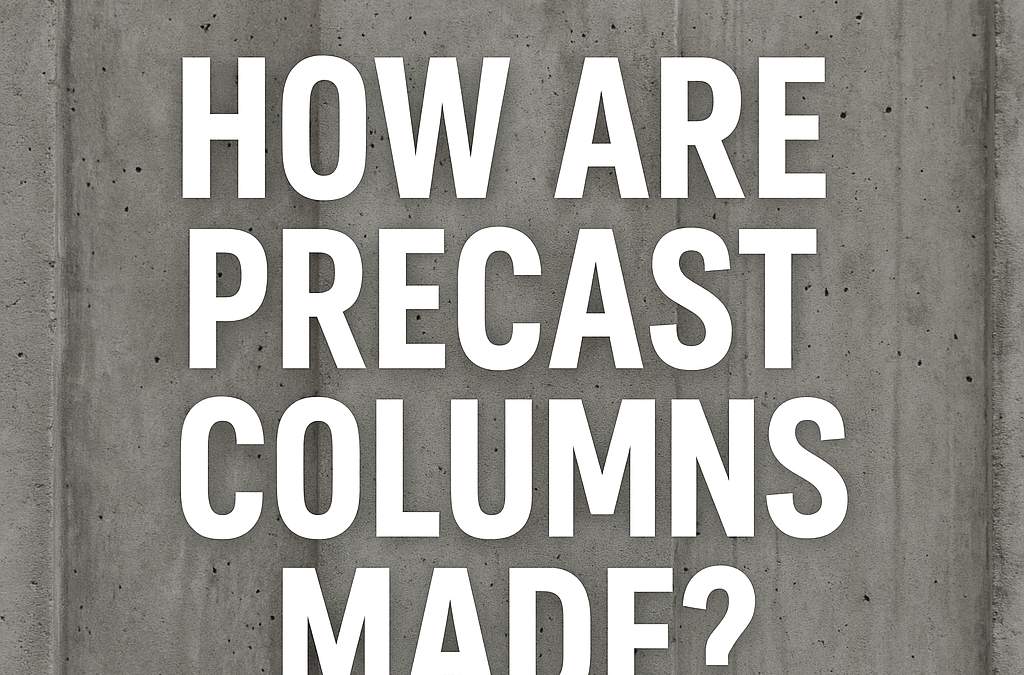TL;DR: How Are Precast Concrete Columns Made and Why Do They Matter?
Precast concrete columns are precision-engineered vertical supports manufactured off-site in controlled environments, then delivered and installed on-site for rapid, high-quality structural builds.
- Factory-made using molds, reinforced steel, and high-strength concrete
- Controlled curing ensures consistent durability and load performance
- Transported and installed using cranes and lifting systems
- Accelerates timelines while maintaining structural quality
- Used in office buildings, parking decks, hospitals, and infrastructure
- Built to code under ASTM, ACI, and PCI standards
- Support long-term strength in load-bearing architectural systems
In modern construction, precast columns offer a perfect blend of speed, safety, and strength — making them essential for efficient, future-ready building projects.
Concrete columns are the backbone of countless structures, from commercial buildings to infrastructure projects. As a critical component of load-bearing frameworks, understanding how precast columns are made offers insight into the intricate processes behind modern construction efficiency and structural integrity. Let’s take a detailed look from a construction engineering perspective.
What Are Precast Structural Columns?
Precast concrete columns are vertical structural elements manufactured off-site under controlled factory conditions and then transported to the job site for assembly. Unlike cast-in-place columns, precast columns provide superior quality control, faster construction timelines, and excellent durability.
At their core, precast structural columns are designed to transfer vertical loads from slabs and beams down to the foundations — a topic we dive deeper into when comparing pile vs pier foundation systems.
According to a publication from the Precast/Prestressed Concrete Institute (PCI), precast components like columns significantly enhance project timelines and safety, offering performance and aesthetic advantages.
Step-by-Step Process: How Precast Columns Are Made
1. Design and Engineering
-
Structural engineers define the column’s dimensions, load requirements, reinforcement layout, and connection details.
-
Computer-Aided Design (CAD) models and structural simulations optimize strength and durability.
For more on the different types of structural columns used in construction, check out our guide on load-bearing structural column types.
2. Formwork Preparation
-
Steel or fiberglass molds are used to create uniform, repeatable shapes.
-
Molds are thoroughly cleaned and treated with release agents to ensure smooth column surfaces.
3. Placement of Reinforcement
-
Reinforcing steel cages are precisely fabricated and placed within the mold.
-
For some columns, post-tensioning cables or prestressing strands are added to enhance load-bearing capabilities.
While this article focuses on columns, many of the same manufacturing principles apply to deep foundation systems like precast concrete piles, which play a different but equally important structural role.
4. Concrete Casting
-
High-strength concrete is poured into the mold, ensuring even distribution around the reinforcement.
-
Vibrators are used to eliminate air pockets and ensure compactness.
5. Curing
-
Columns undergo controlled curing processes to reach optimal strength.
-
Accelerated curing methods, such as steam curing, are often used to speed up production without sacrificing quality.
6. Finishing and Inspection
-
Surface finishes (e.g., polished, exposed aggregate) may be applied based on architectural needs.
-
Rigorous inspections and non-destructive testing methods verify structural integrity.
7. Transportation and Installation
-
Once fully cured, precast columns are transported to the site using specialized trailers and cranes.
-
Proper handling minimizes the risk of cracking or damage during movement.
Key Advantages of Precast Structural Columns
| Feature | Benefit |
|---|---|
| Quality Control | Factory environment reduces variability |
| Speed of Construction | Parallel site and column work save time |
| Durability | High-strength concrete resists environmental wear (Durability is also a key factor when choosing precast concrete pilings for foundation work, especially in flood-prone or coastal areas.) |
| Aesthetic Flexibility | Custom finishes and shapes available |
| Structural Performance | Precision engineering enhances load capacity |
Using a precast structural column system enables construction teams to deliver complex, multi-story projects with greater reliability and efficiency.
Applications of Precast Columns
Precast concrete columns are employed across a wide range of sectors:
-
Commercial buildings: Office towers, malls, parking structures
-
Educational facilities: Schools, universities, libraries
-
Healthcare: Hospitals and medical centers
-
Industrial projects: Warehouses, factories, heavy equipment support structures
-
Transportation: Bridges, airports, transit hubs
Quality Standards and Certification
To ensure performance, precast columns are manufactured following stringent industry standards, such as:
-
ASTM C94 for ready-mix concrete specifications
-
ACI 318 for building code requirements in structural concrete
-
PCI Plant Certification programs for precast quality assurance
Meeting these standards guarantees that precast columns can endure not only the loads they bear but also environmental stresses over decades of service.
Of course, understanding the distinction between components is also vital — for example, see how a beam vs column comparison highlights their unique roles in a structural system.
Real-World Case Study: Commercial Parking Structures
Precast columns have revolutionized parking structure construction by dramatically reducing on-site construction time. Instead of laboriously pouring and curing columns on-site, developers can erect multiple levels within weeks, not months — improving return on investment and minimizing disruptions in urban environments.
How Precast Columns Strengthen Modern Construction
Mastering the process of how precast columns are made is vital for construction managers, structural engineers, and developers seeking to leverage the full potential of modern building techniques. With their blend of precision, durability, and aesthetic flexibility, precast structural columns form the literal and metaphorical pillars of today’s built environment. When properly engineered and installed, they deliver not only strength and resilience but also the speed and efficiency essential for success in today’s competitive construction landscape.
Frequently Asked Questions About Precast Concrete Columns
What is a precast concrete column?
A precast concrete column is a vertical structural element manufactured off-site in a controlled facility and then transported to the construction site. It provides load-bearing support and is often used in commercial, industrial, and infrastructure projects for faster, more consistent construction.
How are precast columns different from cast-in-place columns?
Precast columns are made off-site under controlled conditions, allowing for better quality control, quicker installation, and minimal site disruption. Cast-in-place columns are poured and cured on-site, which can be more time-consuming and weather-dependent.
Where are precast concrete columns commonly used?
These columns are widely used in office buildings, parking structures, hospitals, schools, industrial warehouses, and transportation hubs. Their durability and speed of deployment make them ideal for modern construction.
Are precast columns strong enough for multi-story buildings?
Yes. Precast columns are engineered to meet strict structural codes and are capable of supporting heavy vertical loads. When designed properly, they perform exceptionally well in multi-story and high-load applications.
What standards govern the production of precast concrete columns?
Precast columns are manufactured according to standards like ASTM C94, ACI 318, and PCI certification programs. These ensure consistent quality, structural integrity, and long-term durability.

